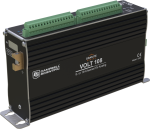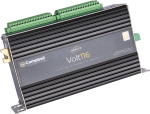This product is no longer available. Some accessories, replacement parts, or services may still be available.

| Services Available | |
|---|---|
| Repair | Yes |
| Calibration | Yes |
| Free Support | Yes |
Overview
The CR3000 Micrologger® supports complex applications with many sensors. It is fast and powerful enough to handle extended eddy-covariance systems with full energy-balance systems. Multiple CR3000s can be configured as a network or units can be deployed individually.
Designed for stand-alone operation in harsh, remote environments. The CR3000 consists of a compact, integrated package with a built-in power supply, a 128-by-64-pixel backlit graphical or eight-line numeric display, and a 16-character keyboard.
Read MoreBenefits and Features
- Ideal applications include eddy covariance, wind profiling, HVAC, weather stations, vehicle testing, air quality, process control, mesonet systems, agriculture, soil moisture, time-domain reflectometry, water quality
- Integrated keyboard and display screen let you program, manually initiate data transfers, and view data, all on site.
- Includes a current excitation channel allowing direct connection of PRTs or other sensors that use a current excitation
- Serial communications with serial sensors and devices supported via I/O port pairs
- Supports PakBus, Modbus, SDI-12, and DNP3 protocols
- Communicates via various options: TCP/IP, email, FTP, web server.
- Gas Discharge Tube (GDT) protected inputs
- Flexible power and communication options make it ideal for remote locations.
- Compatible with channel expansion peripherals allowing you to expand your system
- Battery-backed clock that ensures accurate time is maintained while data logger is disconnected from battery power
- Contains custom ASIC chip that expands pulse count, control port, and serial communications capabilities
- Program with LoggerNet, PC400, or Short Cut to fit your setup
- Collects and stores data and controls peripherals as the brain of your system
Images









Technical Description
Housed in a portable, self-contained package, the CR3000 Micrologger consists of measurement and control electronics, communication ports, 16-character keyboard, display, power supply, and carrying handle. The integrated display shows 8 lines x 21 characters (64 x 128 pixels).
The CR3000 has a choice of three power-supply base options (alkaline, rechargeable, or no battery). Low power consumption allows the Micrologger to operate for extended time periods on its battery recharged with a solar panel—eliminating the need for AC power. It suspends execution when primary power drops below 9.6 V, reducing the possibility of inaccurate measurements.
The on-board operating system includes measurement, processing, and output instructions for programming the datalogger. The programming language, CRBasic, uses a BASIC-like syntax. Measurement instructions specific to bridge configurations, voltage outputs, thermocouples, and pulse/frequency signals are included. Processing instructions support algebraic, statistical, and transcendental functions for on-site processing. Output instructions process data over time and control external devices.
Videos & Tutorials
Compatibility
Please note: The following shows notable compatibility information. It is not a comprehensive list of all compatible products.
Sensors
| Product | Compatible | Note |
|---|---|---|
| PC400 | Version 1.3 or higher |
Miscellaneous
| Product | Compatible | Note |
|---|---|---|
| PC200 (retired) | ||
| PCONNECT (retired) | Version 3.2 or higher | |
| PCONNECTCE (retired) | Version 2.1 or higher | |
| Short Cut | ||
| VISUALWEATHER | Version 2.0 or higher |
Additional Compatibility Information
Sensors
With several channel types, the CR3000 is compatible with nearly every available sensor, including thermocouples, SDI-12 sensors, and 4 to 20 mA sensors. A custom ASIC chip expands its pulse count, control port, and serial communications capabilities. The CR3000's I/O ports can be paired as transmit and receive, allowing serial communications with serial sensors and devices.
Measurement & Control Peripherals
The CR3000 is compatible with all of our CDMs (requires an SC-CPI), SDMs, multiplexers, vibrating wire interfaces, terminal input modules, and relays.
Communications
The CR3000 communicates with a PC via direct connect, Ethernet interfaces, multidrop modems, short-haul modems, phone modems (land line, digital cellular, and voice-synthesized), RF telemetry, and satellite transmitters (Argos, High Data Rate GOES, and Meteosat).
Data can be viewed on its onboard keyboard display, user-supplied iOS or Android device (requires LoggerLink), CD295 DataView II Display, or a user-supplied PDA (PConnect or PConnectCE software required).
Compatible external data storage devices are the CFM100, NL115, and SC115.
Enclosures
The CR3000 can be housed in an ENC12/14, ENC14/16, ENC16/18, ENC24/30, or ENC24/30S enclosure.
Power Supplies
The CR3000 is typically powered by its on-board alkaline or rechargeable power supply (see Ordering Info). When the rechargeable power supply is used, its internal 7 A h sealed rechargeable battery needs be charged via a vehicle (requires the DCDC18R), solar panel, or ac wall charger.
The CR3000 can also come with a low-profile base that requires a user-supplied dc source. It is preferred when the system’s power consumption needs a larger capacity battery or when it’s advantageous for the Micrologger to be thinner and lighter.
Software
CRBasic, the CR3000's full programming language, supports simple or complex programming and many on-board data reduction processes. Compatible software includes:
- Short Cut
- PC200W
- PC400 (version 1.3 or higher)
- LoggerNet (version 3.2 or higher)
- RTDAQ (version 1.0 or higher)
- PConnect (version 3.2 or higher)
- PConnectCE (version 2.1 or higher)
- VisualWeather (version 2.0 or higher)
Specifications
| -NOTE- | Note: Additional specifications are listed in the CR3000 Specifications Sheet. |
| Operating Temperature Range |
|
| Maximum Scan Rate | 100 Hz |
| Analog Inputs | 28 single-ended or 14 differential (individually configured) |
| Pulse Counters | 4 |
| Voltage Excitation Terminals | 4 (VX1 to VX4) |
| Communications Ports |
|
| Switched 12 Volt | 2 terminals |
| Digital I/O |
|
| Input Limits | ±5 Vdc |
| Analog Voltage Accuracy | ±(0.04% of reading + offset) at 0° to 40°C |
| ADC | 16-bit |
| Power Requirements | 10 to 16 Vdc |
| Real-Time Clock Accuracy | ±3 min. per year (Correction via GPS optional.) |
| Internet Protocols | FTP, HTTP, XML POP3, SMTP, Telnet, NTCIP, NTP, |
| Communication Protocols | PakBus, Modbus, DNP3, SDI-12, SDM |
| Idle Current Drain, Average | 2 mA (@ 12 Vdc) |
| Active Current Drain, Average |
|
| Dimensions |
|
| Weight |
|
Related Documents
Product Brochures
Technical Papers
- Voltage Accuracy, Self-Calibration, and Ratiometric Measurements
- Preventing and Attacking Measurement Noise Problems
- Benefits of Input Reversal and Excitation Reversal for Voltage Measurements
- FTP Streaming
- BACnet to Modbus Protocol Conversion (App. Note: 1M-C)
- Serial Sensors: Interfacing with CSI Dataloggers (App. Note Code: 2MI-V)
- CF Card Information (3SM-F)
- EKO MS-700 Spectroradiometer Interfaced with a CR3000 Datalogger (App. Note Code: 2RA-J)
- EKO MS-710 and MS-712 Broadband Infrared Spectroradiometers (WISER Series) with CR3000 Datalogger (App. Note Code: 2RA-K)
Compliance
Downloads
CR3000 OS v.32.07 (4.39 MB) 15-05-2024
Execution of this download installs the CR3000 Operating System and Compiler on your computer. It also updates the CR3000 support files for the CRBasic Editor.
Note: The Device Configuration Utility is used to upload the included operating system to the datalogger.
Upgrading from versions prior to version 28 of the Operating System will reset the datalogger’s CPU drive. This is due to a change in the format of the file system from FAT16 to FAT32. In order for the datalogger to operate correctly, as part of the upgrade, the CPU drive is formatted to FAT32. Any programs stored and running from the CPU drive will be lost. It is not recommended to update the datalogger’s Operating System over a remote connection where program control regulates the communication equipment (turning it on or off, etc.). In these cases, an on-site visit and a backup using DevConfig’s backup utility is necessary to update the datalogger’s Operating System.
Watch the Video Tutorial: Sending an OS to a Local Datalogger.
In all cases where the datalogger is being updated from an Operating System prior to 28, the use of DevConfig’s backup utility is recommended due to the CPU drive being formatted using the new FAT32 format.
Device Configuration Utility v.2.32.01 (47.7 MB) 15-04-2025
A software utility used to download operating systems and set up Campbell Scientific hardware. Also will update PakBus Graph and the Network Planner if they have been installed previously by another Campbell Scientific software package.
Supported Operating Systems:
Windows 11 or 10 (Both 32 and 64 bit)
Related FAQs
Number of FAQs related to CR3000: 145
Expand AllCollapse All
-
Look for a stamp on top of the battery. The stamp may be in a date format of YYMMDDXX where:
- YY is the year.
- MM is the month.
- DD is the day.
- XX is the manufacturing plant.
This indicates the age of the battery.
-
Yes. Campbell Scientific offers a variety of telecommunications options besides Ethernet, including spread-spectrum radios, licensed radio-frequency modems, cellular modems, satellite transmitters (send data only), land-line phone modems, and other direct connection methods.
-
Yes. A local PakBus network can be created using a single COM─COM4 serial port on each CR3000.
-
-
The CR3000 can measure analog voltages over the range of ±5 V. Sensors with outputs beyond that range may have their signals conditioned with voltage dividers to be compatible with the CR3000. The CR3000 may supply power to sensors through various channels: voltage and current excitation, continuous analog output, regulated 5 V, unregulated 12 V, and switched 12 V.
-
This depends on the average current drain on the battery and whether there is a solar panel or wall charger connected to the charger. For guidance on determining average current drain, see our "Power Supplies" application note.
-
Yes. Contact Campbell Scientific for replacement pricing and availability.
-
Telemetry peripherals are discussed and compared in the “Data Storage & Retrieval Peripherals” brochure.
Articles and Press Releases
Case Studies
Overview The Chauvet-Pont d'Arc and Aven d'Orgnac caves are home to prehistoric treasures of rare artistic......read more
As part of the United Nations Development Programme's (UNDP) Crisis Prevention and Resilience Building component,......read more
The Delaware Department of Transportation (DelDOT) notified Intelligent Infrastructure Systems (IIS) and Pennoni of the......read more
In April of 2015, Sandia National Laboratories (SNL) contracted with Montrose Air Quality Services (MAQS)......read more
The Warra long-term ecological research (LTER) site located in Southwestern Tasmania was founded in 1995......read more
The Warra long-term ecological research (LTER) site located in Southwestern Tasmania was founded in 1995......read more
The cultivation of rice—the staple food for India, as well as for approximately half the......read more
On March 14, 2016 the European Space Agency (ESA) launched the first mission in the......read more








































